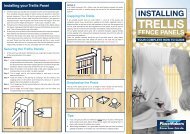what we learned from christchurch taking the risk out ... - PlaceMakers
what we learned from christchurch taking the risk out ... - PlaceMakers
what we learned from christchurch taking the risk out ... - PlaceMakers
Create successful ePaper yourself
Turn your PDF publications into a flip-book with our unique Google optimized e-Paper software.
FEATURESCCANZPaving <strong>the</strong> way – Design (Part 1)Driveways, paths and patios are among <strong>the</strong> key finishing touches that complete a home.This second article in CCANZ’s series on residential concrete focuses on designThe basic function of residentialpavements such as driveways,paths and patios is to providesafe, easy access onto or arounda property. Concrete is typicallyused to not only provide a durablepaving surface sloped to providesurface water run-off, but one whichcan also incorporate a wide rangeof decorative finishes to complement<strong>the</strong> design and landscaping of <strong>the</strong>residence.While providing a concrete pavement on<strong>the</strong> ground is relatively straightforward,<strong>the</strong>re are many aspects of design andconstruction that need to be consideredin order to produce a finished productthat will satisfy both <strong>the</strong> functional andaes<strong>the</strong>tic requirements demanded byhomeowners.CONCRETE STRENGTHConcrete with a specified compressivestrength of 20 MPa compliant withNZS 3104 is recommended forresidential pavements. A higherstrength may be required in certainsituations, such as:• Heavier loads. If <strong>the</strong> pavement isbeing used by vehicles bet<strong>we</strong>en 3 and10 tonne gross mass, and infrequentlyby heavier vehicles that do not exceed<strong>the</strong> statutory limits for tyre, wheeland axle loads, a specified strength of25 MPa or 30 MPa is recommended.Such pavements also need to bethicker (see Table 1).• Abrasion resistance. This is <strong>the</strong> abilityof <strong>the</strong> concrete surface toresist <strong>we</strong>ar; it is directly related to<strong>the</strong> strength of concrete and <strong>the</strong>quality of <strong>the</strong> surface finish. A 20 MPaconcrete is satisfactory for mostresidential paving applications, includingtypical driveways. The higher strengthrecommended for heavier loadswill also produce a higher abrasionresistance provided <strong>the</strong> surface finishand curing are carried <strong>out</strong> correctly.• Freezing and thawing.A 25 MPa concrete should be usedif <strong>the</strong> pavement is subjected tooccasional freezing. Where morethan 50 freezing cycles occur eachyear, a 30 MPa concrete should beused. Also, an air-entraining agentshould be used in <strong>the</strong> concrete mixtargeting a 5% air content.The constructionof driveway pavementswith<strong>out</strong> reinforcing meshis not recommendedTHICKNESSTable 1 shows recommended thicknessalong with concrete compressivestrength. The load <strong>the</strong> slab can carry isalso dependent on <strong>the</strong> adequacy of <strong>the</strong>subgrade to support <strong>the</strong> loaded slab.OTHER PROPERTIESIf properties in addition to strength arerequired, ‘Special Concrete’ shouldbe specified and <strong>the</strong> means by whichcompliance is established. For colouredand decorative pavement finishes,some of <strong>the</strong> properties (apart <strong>from</strong> <strong>the</strong>strength) that may be required include:• Colour pigments. Supplier, colourand percentage by <strong>we</strong>ight of cementto be used.Pavement UsePaths & Patios(Foot traffic only)Typical DrivewayVehicle use < 3 t grossPavement with vehicles3 t to 10 tTable 1: Pavement thickness and specified concrete compressive strength• Aggregates. For exposedaggregates, any information necessaryto identify <strong>the</strong> stone required – size,type, texture, colour (eg nominal10 mm aggregate consisting of 90%brown rounded river gravel and10% crushed white quartz).• Cement colour. Normal grey,off-white or white. Note that <strong>the</strong>availability of <strong>the</strong>se should be checkedprior to specifying. An alternative toachieve a lighter colour is <strong>the</strong> use ofa titanium white colour pigment.PERMEABLE PAVEMENTSPermeable (or pervious) pavementsare being specified in areas whererun-off <strong>from</strong> existing hard surfacesdue to extreme rainfall events causesoverloading of <strong>the</strong> stormwater systems.Permeable concrete is similar tono-fines concrete and has continuousvoids, which allow water to infiltratethrough <strong>the</strong> pavement. Alternatively,permeable pavers can be used.The water is held in storage under <strong>the</strong>pavement, which effectively reduces<strong>the</strong> peak run-off entering <strong>the</strong> sub-gradeor <strong>the</strong> stormwater system. Informationon permeable pavements is found atwww.concretenetwork.com/pervious.SEGMENTAL PAVEMENTSConcrete segmental pavers ranging<strong>from</strong> small brick-sized units to <strong>the</strong>larger flag pavers are availablein a variety of colours, finishes andPavementThicknessPavement ConcreteSpecified Strength75 mm 20 MPa100 mm 20 MPa150 mm 25 or 30 MPa18www.ccanz.org.nz
















